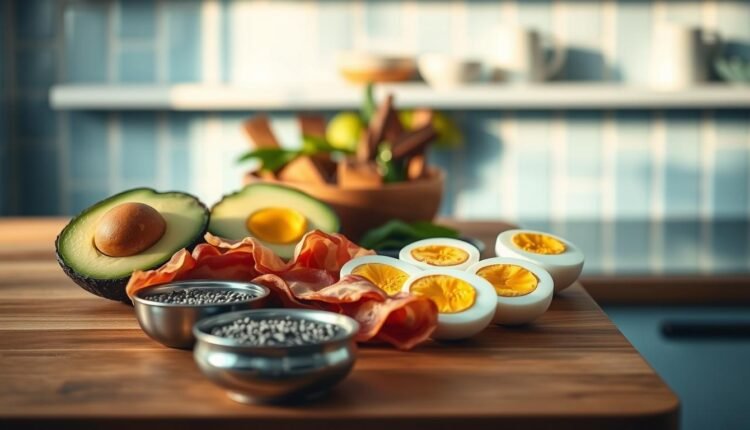Make Ahead Breakfast Keto Options With Healthy Fats
Transform your mornings with easy keto make-ahead breakfast ideas. From savory egg muffins to roasted cauliflower bowls, prep meals that fuel and simplify your day.
What if your mornings could feel less chaotic without sacrificing flavor or nutrition? I used to dread the 6 a.m. scramble—burnt toast, forgotten lunches, and that sinking feeling of starting the day behind. Then I discovered the magic of prepping meals that keep energy high and stress low, even on hectic weekdays.
Roasted cauliflower, savory sausage, and Cabot’s Seriously Sharp Cheddar became my secret weapons. These ingredients aren’t just tasty—they’re packed with the healthy fats your body craves on a keto-friendly plan. Best part? They’re ready to grab straight from your fridge or freezer, thanks to microwave-safe containers that save precious minutes.
I’ve learned from real families (and my own trial-and-error moments) that simplicity wins. One mom swears by doubling her egg batches on Sundays; another adds diced avocado for extra creaminess. These tricks aren’t complicated—just smart. Want to build your own meal planning system? Start with what you love, then let routine do the rest.
Mornings don’t have to mean rushed decisions or bland meals. With a little prep, you’ll savor every bite—even while juggling coffee spills and school backpacks. Trust me: Your future self will thank you.
Introduction: Streamline Your Morning Routine
Ever wonder how some people glide through mornings while you’re still hunting for your keys? It starts with a rhythm—one that balances nutrition and simplicity. Let’s talk about how small changes can transform your AM hustle.
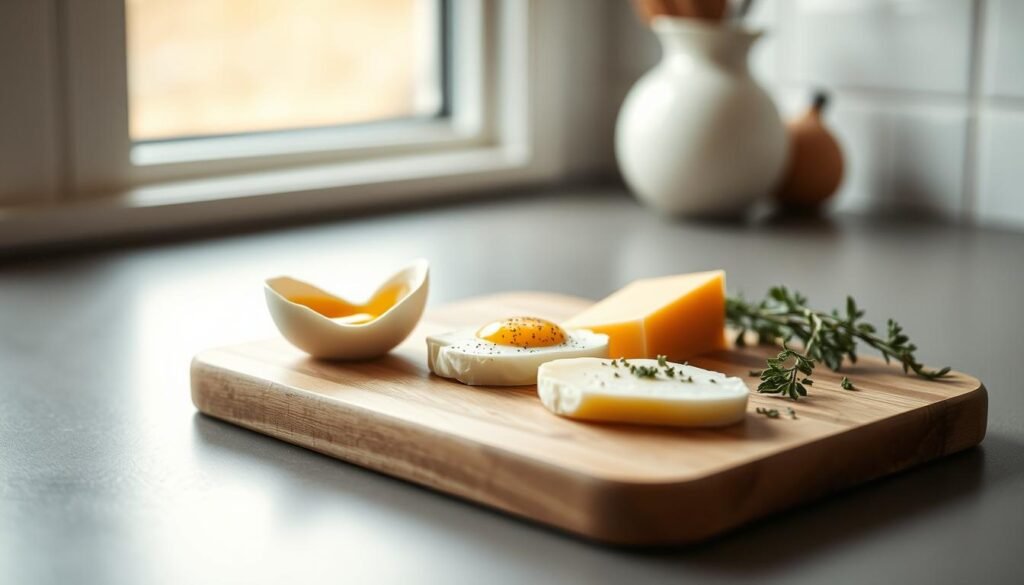
What a Keto Lifestyle Really Means
Eating this way focuses on fueling your body with fats instead of sugars. Think avocado instead of toast, eggs over cereal. I learned this the hard way after burning three batches of frittatas (pro tip: silicone muffin pans prevent sticking). The goal? Steady energy without the 10 a.m. crash.
Why Prepping Wins Every Time
Last Tuesday, my fridge saved me. While scrambling to find lunchboxes, I grabbed pre-portioned spinach and cheddar egg bites—ready in 90 seconds. That’s the power of planning. Studies show those who prep meals eat 40% more veggies and waste less time deciding what to cook.
| Aspect | Traditional Breakfast | Prepped Keto Breakfast |
|---|---|---|
| Time Spent | 15+ minutes daily | 2 minutes reheating |
| Stress Level | High (rushed decisions) | Low (grab-and-go) |
| Nutrition | Often carb-heavy | Balanced fats/proteins |
Eggs become your MVP here. Whip them into muffins with bacon crumbles, bake them in avocado halves, or scramble a big batch for wraps. One Sunday prep session creates five days of no-stress meals. Your family gets quality fuel, and you keep your sanity—win-win.
The Benefits of Healthy Fats in Your Breakfast
Ever notice how some meals keep you full until noon while others leave you hungry by 9 AM? It all comes down to what’s on your plate—specifically, the quality fats that turn a quick bite into lasting fuel.
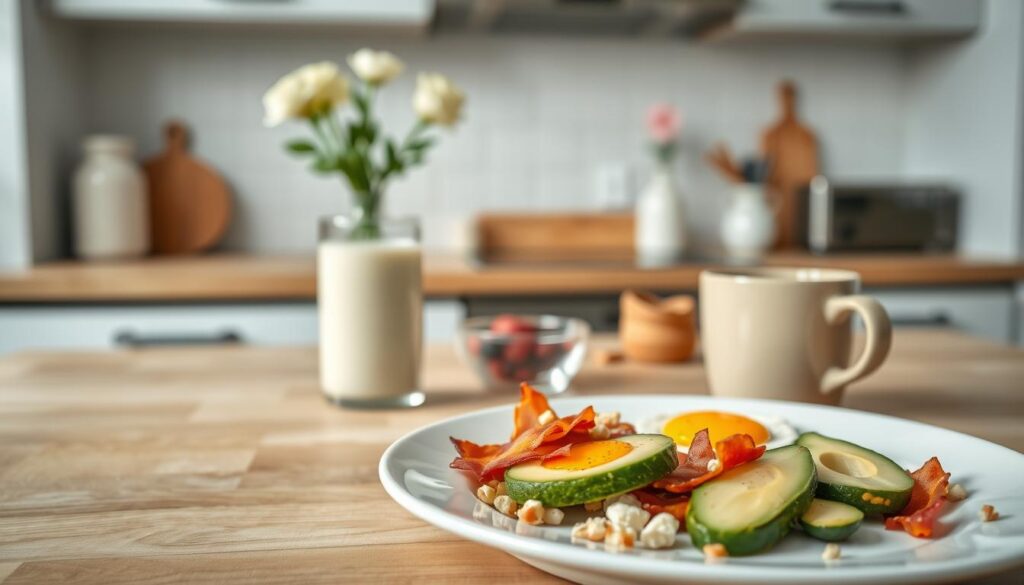
Boosting Energy and Satiety
Cabot’s Seriously Sharp Cheddar became my go-to after I realized how a sprinkle transforms scrambled eggs. High-fat ingredients like this aren’t just tasty—they slow digestion, keeping hunger pangs away. One study found meals rich in quality fats increase fullness by 30% compared to carb-heavy alternatives.
| Fat Source | Energy Boost | Satiety Duration |
|---|---|---|
| Avocado | Steady | 4-5 hours |
| Cheese (Cabot) | Immediate | 3-4 hours |
| Olive Oil | Gradual | 2-3 hours |
Roasting veggies like cauliflower or zucchini removes excess water, preventing soggy egg bakes. Dryer textures mean better reheating results—a game-changer for office-friendly breakfast prep.
My rule? Prioritize fats that multitask. A dollop of full-fat Greek yogurt adds creaminess and protein. A handful of nuts delivers crunch while stabilizing blood sugar. And always choose cheeses aged longer—they pack more flavor per ounce, so you use less without sacrificing taste.
Last week, I tested this by adding roasted Brussels sprouts with pancetta to my morning routine. Not only did it curb my snack cravings, but I also felt more focused during back-to-back meetings. That’s the power of smart fat choices.
Top Tips for make ahead breakfast keto options
We’ve all had those weeks where even boiling water feels overwhelming. Here’s the good news: A well-stocked freezer can turn chaos into calm. Let me share the strategies that saved my sanity during back-to-school season—and still work now that I’m juggling remote work.
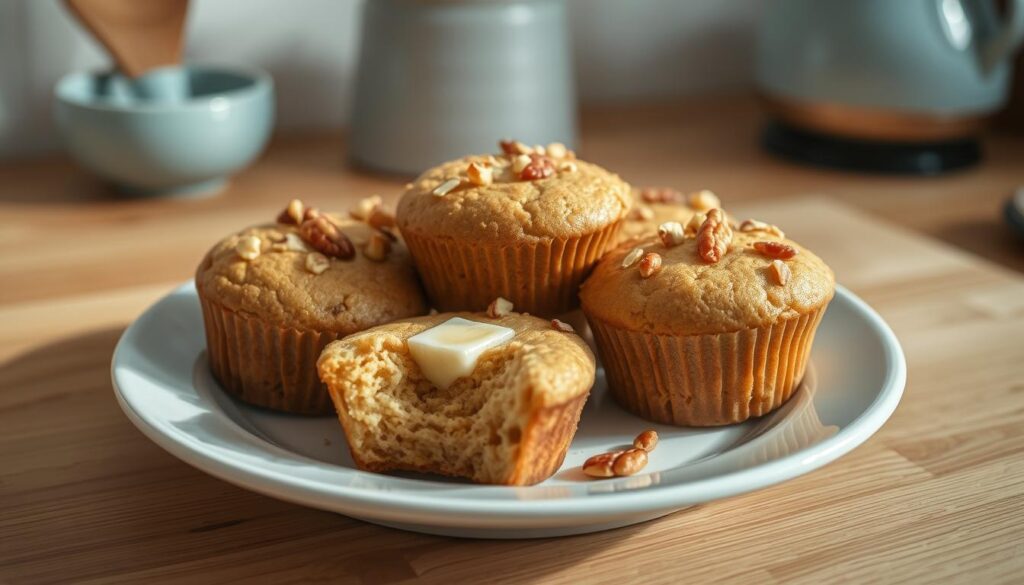
Batch Like a Pro
I once burned three batches of almond flour muffins trying to multitask. Now I stick to this formula: Choose one portable base (like muffins), one protein-packed add-in (sausage crumbles), and one veggie (roasted zucchini works wonders). Sunday afternoons are perfect for:
- Whisking 18 eggs with cream for muffin tin pours
- Roasting two sheet pans of veggies (cauliflower + broccoli = no flavor fatigue)
- Pre-cooking sausage patties between parchment paper
Store components separately for mix-and-match freedom. Glass containers with dividers keep textures crisp—nobody wants soggy spinach by Thursday.
My favorite hack? Silicone muffin molds. They pop out egg bites effortlessly, and the neutral shape works for sweet or savory combos. Try blending cottage cheese into your egg mixture—it adds creaminess without overpowering other flavors.
Label everything with dates using painter’s tape. Frozen items stay fresh 3 months, but let’s be real—they’ll disappear faster. Pair muffins with a quick avocado slice or handful of nuts for balanced energy. Tomorrow’s you will high-five today’s you when lunchtime arrives without snack emergencies.
Improper storage techniques, like overstuffing containers, can lead to freezer burn. Always leave room for expansion to preserve flavor and texture.
Selecting the Best Ingredients for a Keto Meal
Choosing the right ingredients can turn a good meal into a great one—especially when every bite counts toward your goals. I learned this after a disastrous attempt with rubbery eggs and bland sausage. Now, I treat my grocery list like a treasure map, hunting for items that deliver flavor and nutrition without breaking the bank.
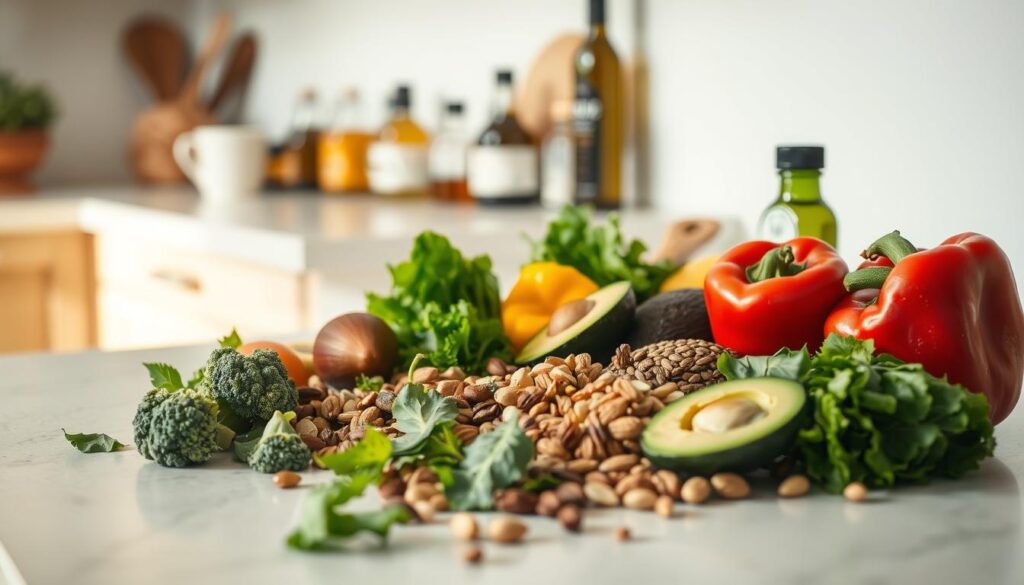
Protein Powerhouses: Eggs, Cheese & Sausage
Not all proteins are created equal. For eggs, I grab pasture-raised varieties—their vibrant yolks add richness to scrambles. Cabot’s Seriously Sharp Cheddar remains my cheese staple (aged 14 months for bold flavor), while Applegate’s pre-cooked chicken sausage saves time without artificial additives. A butcher once told me:
“Quality sausage should list meat as the first ingredient—not fillers.”
Veggies That Pull Their Weight
Roasted cauliflower became my potato substitute after testing six varieties. Its neutral taste absorbs spices beautifully, while spinach adds iron without overpowering dishes. Here’s how common veggies stack up:
| Vegetable | Prep Time | Key Nutrients |
|---|---|---|
| Cauliflower | 25 mins | Vitamin C, K |
| Zucchini | 15 mins | Potassium, Folate |
| Spinach | 2 mins (raw) | Iron, Magnesium |
Almond flour bread works wonders for those missing toast—it’s dense but satisfying. Pair it with avocado mash for a fiber boost. The extra time spent selecting ingredients pays off in meals that keep you full and focused.
Remember: Your diet thrives on variety. Mix textures and colors, and don’t fear experimenting. Your taste buds (and macros) will thank you.
Prepping and Cooking Techniques for Meal Success
Last month, I ruined a batch of egg bites because my zucchini was too watery. That’s when I discovered roasting isn’t just about flavor—it’s texture insurance. Mastering a few simple methods can turn your weekly prep into something that actually works when you’re bleary-eyed at 7 AM.
Roasting Vegetables to Reduce Moisture
Cauliflower taught me this lesson. Chop it into bite-sized florets, toss with avocado oil, and roast at 425°F until edges caramelize. The dry heat pulls out moisture that would otherwise turn your egg dishes soggy. Works wonders for:
- Bell peppers (slice thin for quick roasting)
- Mushrooms (leave whole to retain shape)
- Spinach (quick roast to crisp for toppings)
Eggs demand patience. Scramble them over low heat, stirring constantly with a silicone spatula. They’ll set gradually into creamy curds rather than rubbery chunks. My fail-proof ratio: 1 tablespoon heavy cream per 3 eggs.
Layering matters. Start with roasted veggies at your container’s base, add proteins next, then cheeses or sauces. Use microwave-safe containers with tight lids—glass works best for reheating without flavor transfer.
Three rules I live by:
- Cool all ingredients completely before assembling
- Leave a thumb-width space in containers for expansion during freezing
- Write reheating times on lids with dry-erase markers
These steps take an extra 10 minutes upfront but save you from disappointing, mushy meals later. Trust me—your future self deserves better than steamed-beyond-recognition broccoli.
Avoid using pre-packaged meats with hidden preservatives. Always choose high-quality, additive-free proteins for better health benefits.
Creative Recipe Ideas and Variations
Who says keto meals can’t be playful? I learned this after turning leftover roasted cauliflower into a breakfast bowl that rivaled my old potato hash. The key lies in reimagining classics with low-carb twists—no fancy skills required.
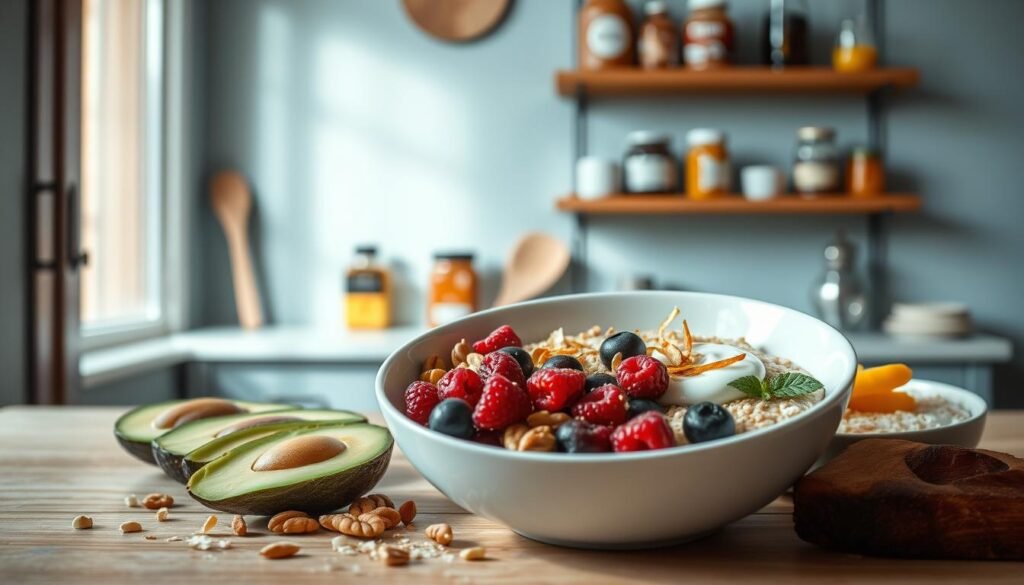
Keto Breakfast Bowls with Cauliflower and Cheese
Roasted cauliflower shines when treated like potatoes. Toss florets with smoked paprika and garlic powder before roasting—they’ll crisp up beautifully. Layer them in jars with scrambled eggs, crumbled bacon, and shredded Gruyère. The result? A hearty base that reheats in 60 seconds.
| Traditional Bowl | Keto Upgrade | Prep Time |
|---|---|---|
| Potato hash | Cauliflower “hash” | 25 mins |
| Toast slices | Almond flour crisp | 18 mins |
| Fruit yogurt | Chia seed pudding | 5 mins |
Exploring Muffins, Breads, and More
Egg muffins became my canvas for flavor experiments. Last week’s batch mixed sun-dried tomatoes, feta, and fresh basil. Freeze them individually—they thaw overnight and travel well in lunchboxes. For bread lovers, try coconut flour loaves infused with rosemary or Everything Bagel seasoning.
Need variety? Swap cheddar for goat cheese in your egg bites. Fold minced jalapeños into muffin batter for heat. One reader told me:
“Adding zucchini ribbons to my almond flour bread gave it moisture without the carbs—game-changer!”
Busy mornings demand flexibility. Pre-portion toppings like toasted pepitas or crispy prosciutto chips. They add crunch to any dish and keep textures exciting all week. Your kitchen isn’t a lab—it’s a playground. Start mixing, and let routine handle the rest.
Essential Tools and Storage Solutions
I once lost a whole batch of cauliflower hash to freezer burn because I used the wrong containers. Now I treat storage choices like ingredient selection—they make or break your carb-conscious efforts. Let’s talk about keeping your creations fresh from Sunday prep to Friday reheating.
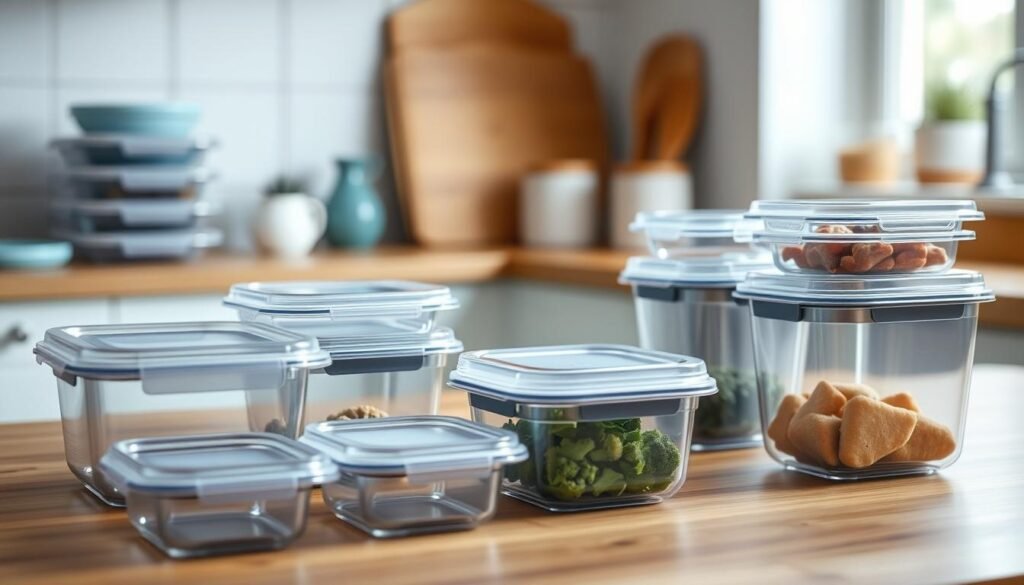
Selecting Microwave and Freezer Safe Containers
Glass containers became my hero after plastic ones warped in the microwave. They’re non-reactive, easy to clean, and handle temperature swings beautifully. But they’re not perfect—heavy for travel, and lids can crack if overfilled. Bamboo options work for dry items like almond flour muffins but warp with saucy dishes.
| Material | Best For | Watch Out |
|---|---|---|
| Glass | Liquid-heavy meals | Weight/breakability |
| Bamboo | Dry snacks | Absorbs odors |
| Compostable Paper | Short-term fridge storage | Not freezer-safe |
A chef friend once told me:
“Your container’s job is to protect flavor and texture—choose like you’re preserving art.”
I follow this with low-carbegg bites by using individual silicone cups inside glass jars. Prevents sogginess and lets me grab one portion without thawing the whole batch.
Weekend warriors, listen up: Always leave thumb-space in containers for expansion. Frozen spinach scrambles need room to breathe. For meals you’ll reheat, avoid plastic entirely—studies show even BPA-free versions can leach chemicals when heated.
Last month, I tested compostable containers with roasted veggie stacks. By Wednesday, the zucchini had turned mushy. Lesson learned: Reserve these for dry items like cheese crisps or nut mixes. Your carb-controlled creations deserve armor that lasts all week.
Three freezer hacks I swear by:
- Wrap individual portions in parchment before stacking
- Label lids with reheating times (dry-erase markers work)
- Rotate older items to the front every weekend
Proper storage isn’t glamorous, but it’s what separates “meh” meals from magic. Treat your containers like teammates—they’ll carry your carb-smart efforts across the finish line.
Always ensure roasted veggies are completely cooled before storing to maintain texture and prevent sogginess during reheating.
Balancing Flavors and Nutritional Needs
Ever tasted a dish that felt flat despite perfect ingredients? I once served egg muffins so bland my partner asked if I’d forgotten salt—turns out, I had. Seasoning isn’t just sprinkling; it’s layering flavors that sing together while hitting your macros. Let’s fix that.
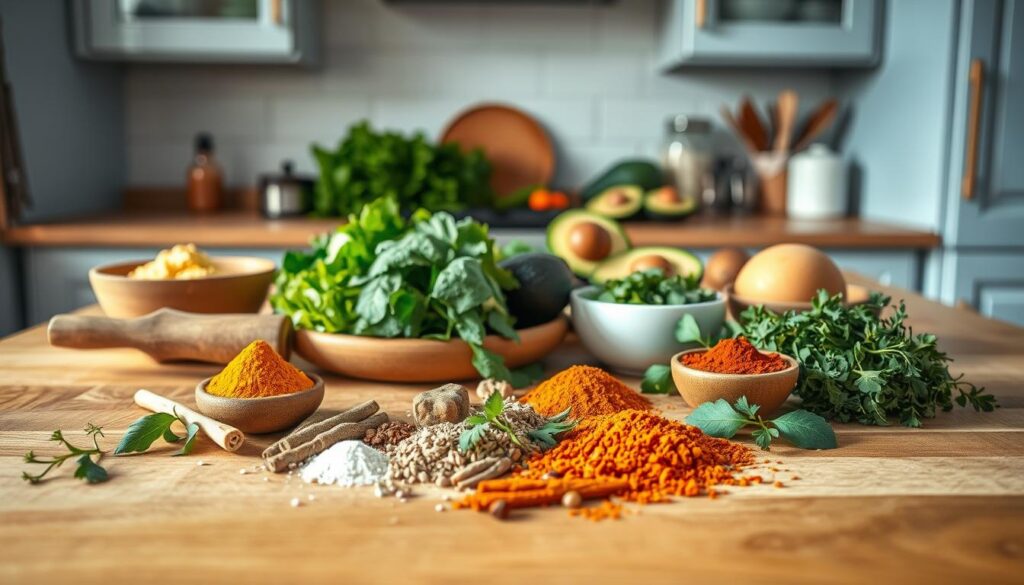
Flavor Alchemy 101
Cabot’s Seriously Sharp Cheddar taught me umami’s power. A quarter-cup adds richness without carbs. But cheese alone won’t cut it—balance savory, spicy, and bright notes. My formula:
- Savory: Nutritional yeast or smoked paprika (1 tsp per 4 eggs)
- Spice: Crushed red pepper flakes or fresh jalapeños (adjust to tolerance)
- Fresh: Chives or lemon zest added after reheating
Last week, I tested this by adding dill and sumac to cauliflower hash. The result? My teen actually finished her veggies. Small tweaks create big wins.
| Seasoning | Flavor Boost | Prep Tip |
|---|---|---|
| Garlic powder | Depth | Mix with olive oil before roasting |
| Cumin | Warmth | Toast seeds, then grind |
| Apple cider vinegar | Brightness | Sprinkle on reheated dishes |
Store-bought blends often hide sugar. Make your own: 2 parts onion powder + 1 part each thyme and rosemary. Label jars with dates—flavors fade after six weeks.
Your turn: Next Sunday, try one new spice. Maybe smoked sea salt on avocado slices or turmeric in scrambled eggs. Taste as you go—your future mornings deserve that spark.
Time-Saving Strategies for Busy Mornings
Ever opened your freezer to find a frostbitten mystery meal? Let’s fix that. Storing food right keeps textures crisp and flavors bright—even after days in cold storage. Your future self deserves better than rubbery eggs or soggy veggies.
Freezing Versus Refrigeration: What Works Best
I learned this the hard way when frozen spinach turned my egg bites into sponges. Now I follow this rule: Refrigerate what you’ll eat in 3 days, freeze the rest. Glass containers with silicone lids prevent freezer burn better than plastic. For sauces? Ice cube trays create single-serving portions that thaw fast.
| Method | Best For | Reheating Tip |
|---|---|---|
| Refrigeration | Cheese-heavy dishes | 50% power, 90 seconds |
| Freezing | Meat/veggie mixes | Defrost overnight first |
Swap regular flour with almond or coconut varieties in muffin recipes—they freeze better and slash carbs. A chef friend once told me:
“Freezing stops the clock, but proper wrapping keeps meals tasting fresh.”
Three game-changing hacks:
- Press parchment paper onto casseroles before sealing—prevents ice crystals
- Label lids with reheating times using washable markers
- Store muffin components separately (dry/wet) to maintain texture
Need to cut carbs further? Use cauliflower instead of oat flour in pancakes—they hold shape better when frozen. Last week’s batch stayed fluffy after two months in deep freeze. Smart storage isn’t just practical—it’s your ticket to calm mornings.
A solid meal prep system sets you up for consistent success, allowing your mornings to feel smooth and productive with minimal stress.
Batch cooking transformed my chaotic mornings into smooth routines. Roasting veggies like zucchini ahead of time creates versatile bases—toss them into scrambles or layer with cheese in jars. Quality fats keep energy steady, while smart storage preserves flavors all week.
I learned zucchini’s magic by accident. Thinly sliced and roasted, it adds texture without overwhelming dishes. Pair it with sharp cheddar or fold into egg muffins for unexpected crunch. These small tweaks turn ordinary meals into something special.
Planning even one day’s worth of meals builds momentum. Start with what excites you—maybe crispy bacon bits or smoked paprika cauliflower. Label containers clearly, and remember: imperfect efforts still beat frantic mornings.
Share your wins! Did roasted Brussels sprouts surprise you? Found a new spice blend? Tag us @Prepistry—we celebrate real kitchen victories. Your day deserves to begin with confidence, not chaos. Let’s cook smarter, together.
Keto Breakfast Casserole with Sausage, Roasted Cauliflower, and Cheddar
A hearty and flavorful breakfast casserole combining savory sausage, roasted cauliflower, and sharp cheddar cheese, perfect for busy mornings or meal prepping.
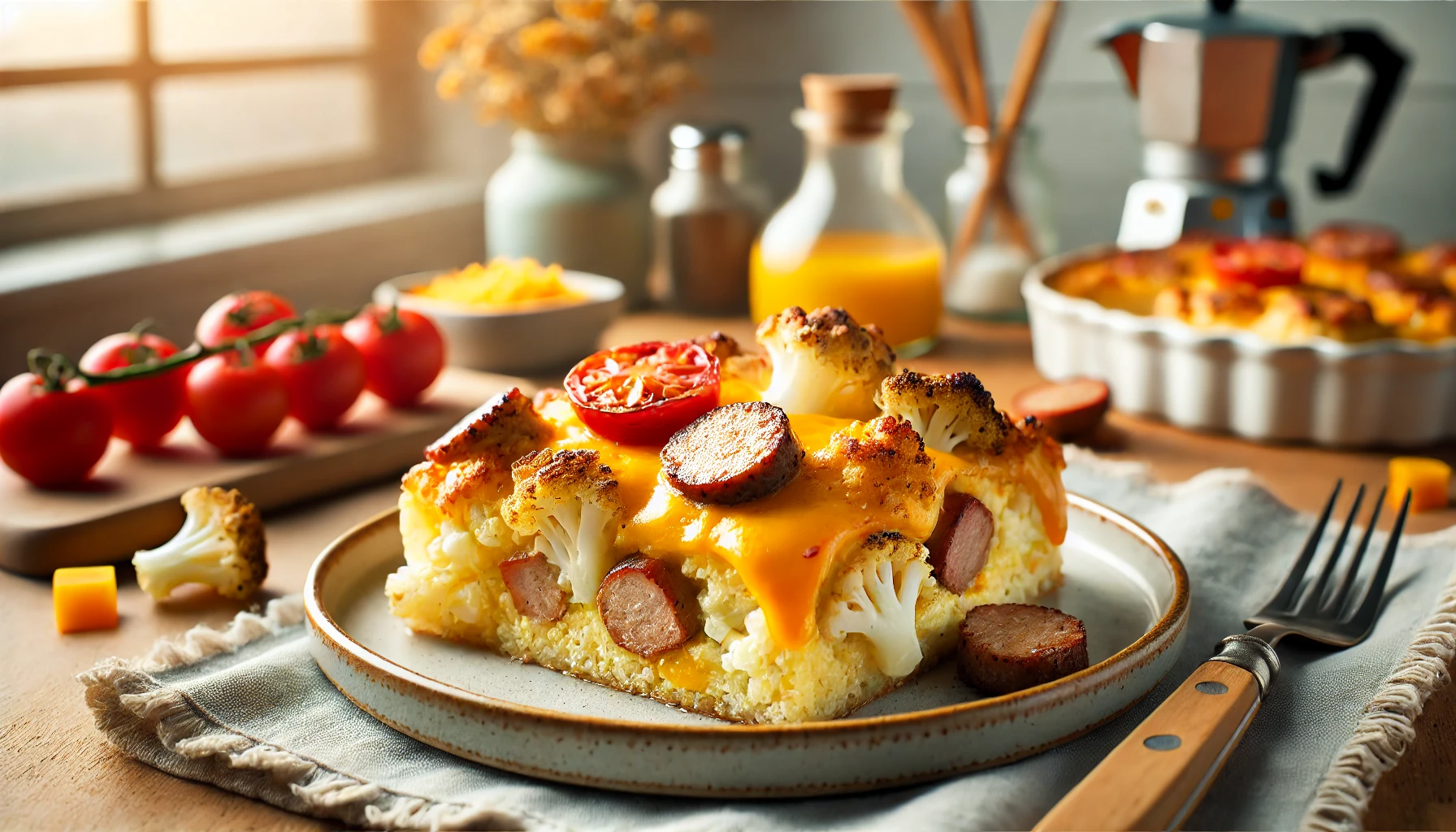
Nutrition Information
Equipment Needed
- 9x13-inch baking dish
- Large skillet
- Mixing bowl
- Whisk
- Knife
- Cutting board
- Measuring cups and spoons
Ingredients
-
10 large eggs
-
1 pound breakfast sausage, crumbled
-
2 cups riced cauliflower
-
1 cup shredded sharp cheddar cheese
-
1/2 cup diced onions
-
1/2 cup diced bell peppers
-
2 cloves garlic, minced
-
1/2 teaspoon salt
-
1/4 teaspoon black pepper
-
1/4 teaspoon smoked paprika
-
1 tablespoon olive oil
Instructions
Recipe Video
BEST BREAKFAST CASSEROLE | easy breakfast casserole with sausage, sweet potato, and more!
A simple and delicious breakfast casserole recipe featuring sausage, sweet potatoes, and other tasty ingredients. Perfect for feeding a crowd or meal prepping for the week.

